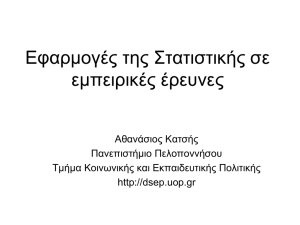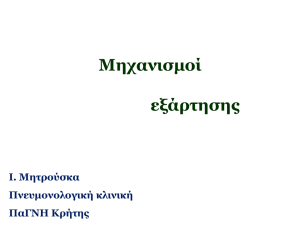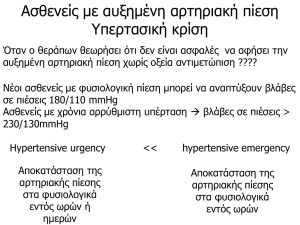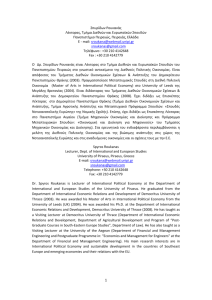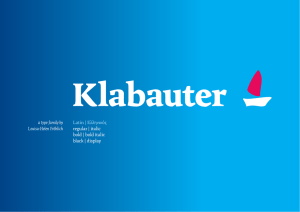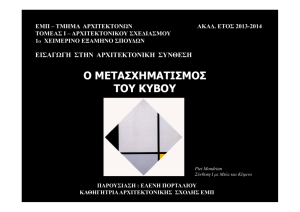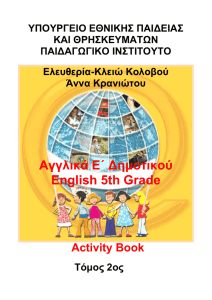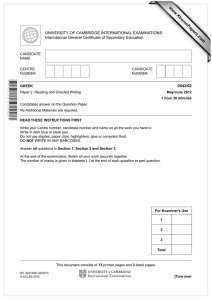Eleutherna and Knossos: ceramic correspondences in the 9th – 7th
advertisement
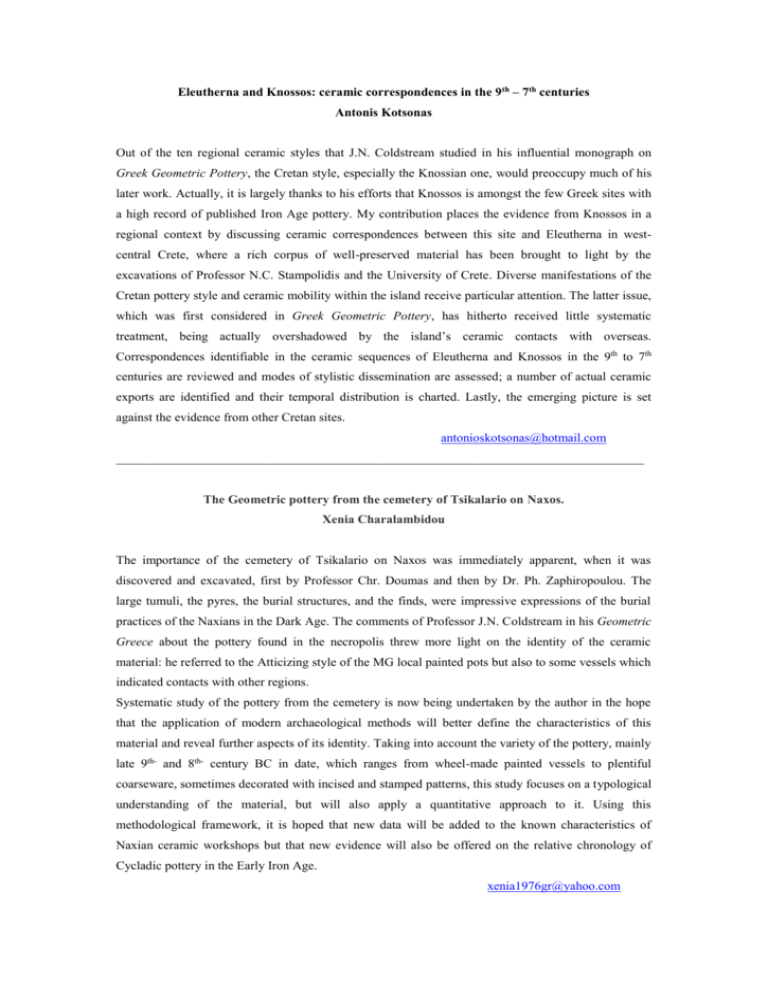
Eleutherna and Knossos: ceramic correspondences in the 9 th – 7th centuries Antonis Kotsonas Out of the ten regional ceramic styles that J.N. Coldstream studied in his influential monograph on Greek Geometric Pottery, the Cretan style, especially the Knossian one, would preoccupy much of his later work. Actually, it is largely thanks to his efforts that Knossos is amongst the few Greek sites with a high record of published Iron Age pottery. My contribution places the evidence from Knossos in a regional context by discussing ceramic correspondences between this site and Eleutherna in westcentral Crete, where a rich corpus of well-preserved material has been brought to light by the excavations of Professor N.C. Stampolidis and the University of Crete. Diverse manifestations of the Cretan pottery style and ceramic mobility within the island receive particular attention. The latter issue, which was first considered in Greek Geometric Pottery, has hitherto received little systematic treatment, being actually overshadowed by the island’s ceramic contacts with overseas. Correspondences identifiable in the ceramic sequences of Eleutherna and Knossos in the 9th to 7th centuries are reviewed and modes of stylistic dissemination are assessed; a number of actual ceramic exports are identified and their temporal distribution is charted. Lastly, the emerging picture is set against the evidence from other Cretan sites. antonioskotsonas@hotmail.com __________________________________________________________________________________ The Geometric pottery from the cemetery of Tsikalario on Naxos. Xenia Charalambidou The importance of the cemetery of Tsikalario on Naxos was immediately apparent, when it was discovered and excavated, first by Professor Chr. Doumas and then by Dr. Ph. Zaphiropoulou. The large tumuli, the pyres, the burial structures, and the finds, were impressive expressions of the burial practices of the Naxians in the Dark Age. The comments of Professor J.N. Coldstream in his Geometric Greece about the pottery found in the necropolis threw more light on the identity of the ceramic material: he referred to the Atticizing style of the MG local painted pots but also to some vessels which indicated contacts with other regions. Systematic study of the pottery from the cemetery is now being undertaken by the author in the hope that the application of modern archaeological methods will better define the characteristics of this material and reveal further aspects of its identity. Taking into account the variety of the pottery, mainly late 9th- and 8th- century BC in date, which ranges from wheel-made painted vessels to plentiful coarseware, sometimes decorated with incised and stamped patterns, this study focuses on a typological understanding of the material, but will also apply a quantitative approach to it. Using this methodological framework, it is hoped that new data will be added to the known characteristics of Naxian ceramic workshops but that new evidence will also be offered on the relative chronology of Cycladic pottery in the Early Iron Age. xenia1976gr@yahoo.com A Figured Geometric Pitcher from Marathon Vicky Vlachou A huge pitcher (Marathon Museum K2210) was found in 1995 inside the disturbed Grave 14 of the necropolis on Marathon Avenue, in front of the formerl American naval communications base at Marathon. The rescue excavation was undertaken by the 2 nd Ephorate of Prehistoric and Classical Antiquities, which had also excavated part of the same cemetery in 1985. This paper deals with the stylistic and iconographical analysis of the Marathon pitcher, an impressive vase 78 cm in height, dated to the late years of the 8th century BC. In a time when the great majority of Attic Workshops produced figured vases, the variety and diversity of the decoration on the Marathon pitcher is still surprising. Human figures, real and mythical creatures are represented in two friezes and six square panes on the neck and the belly of the vessel. A terracotta snake attached to the handle of the vase is the only element that clearly reveals its funerary destination. The iconographic composition alludes to a peaceful and rather festive character. Whether the depiction of so many figures may constitute a theme, or whether their purpose is merely decorative, remains ambiguous. However, the choice of certain themes, and their depiction in metopes and in continuous friezes, may favour the treatment of a certain theme. The figured drawing and the imagery owe much to the Workshop of Athens 894. However, the figured themes of the Late Geometric tradition are enriched by new “Orientalizing” ideas, and the general treatment of the decoration reveals a strong connection with the early works of the Analatos Painter. The Marathon pitcher seems to be the product of a provincial workshop. The secure provenance of the vase offers a strong indication that we are dealing with a local workshop, the activity of which largely coincides with the LG II period. hekataios@yahoo.com __________________________________________________________________________________ Ερέτρια. Η μετάβαση από την ΜΓΙΙ στην ΥΓΙ εποχή. Τα νέα αρχαιολογικά τεκμήρια. Αθανασία Ψάλτη Η παρούσα ανακοίνωση διαπραγματεύεται ένα σημαντικό αριθμό πήλινων αγγείων, μέρος του περιεχομένου ταφικής πυράς, που ήλθε στο φως κατά τη διάρκεια σωστικής ανασκαφής της ΙΑ’ Εφορείας Προϊστορικών και Κλασικών Αρχαιοτήτων, στην Πλατεία Αγοράς της Ερέτριας. Τα αγγεία, θραυσμένα και καμένα βρέθηκαν εντός στρώματος λιπαρής τέφρας, σε άμεση επαφή με τον σύγχρονο υδροφόρο ορίζοντα, δεδομένο το οποίο δυσχέρανε την έρευνα και αποτέλεσε πιθανώς την αιτία αποσύνθεσης του σκελετικού υλικού, που δεν εντοπίστηκε. Ο κατάλογος των αγγείων περιλαμβάνει: δύο υψίποδες κρατήρες, ο ένας μάλιστα εκ των οποίων εμφανίζει σπάνιο εικονιστικό διάκοσμο (αρ. ευρ. 19565), δύο κρατήρες με δακτυλιόσχημη βάση, υδρία αβαφή με ταινιωτό διάκοσμο, κυπριακό δίωτο ληκύθιο (black on red), αποσπασματικώς σωζώμενη οινοχόη με μαστοειδείς αποφύσεις στον ώμο, τουλάχιστον δεκαπέντε σκύφους με διακόσμηση αριστερόστροφου διακεκομμένου μαιάνδρου, ακέραιη πυξίδα με ευρεία βάση και επιπλέον τέσσερις αποσπασματικά διατηρούμενες, τέσσερα καλύμματα πυξίδων, και πήλινα ολόγλυφα ιππάρια που κοσμούσαν καλύμματα πυξίδων. Πλην της κεραμικής, η πυρά περιείχε χρυσή ελασμάτινη ταινία με έκτυπη διακόσμηση γεωμετρικών κοσμημάτων και σκαραβαίο από αιγυπτιακό μπλε με εικονιστική παράσταση. Με βάση τα αντίστοιχα αττικά παράλληλα το σύνολο σχεδόν του κεραμικού υλικού χρονολογείται στο β΄ τέταρτο έως και το μέσον του 8 ου π.Χ. αι., καλύπτει δηλαδή την τελευταία φάση της ύστερης ΜΓΙΙ και την αρχή της ΥΓΙ εποχής. Η μελέτη που θα παρουσιαστεί επικεντρώνεται α) στη χρονολογική και ρυθμολογική ένταξη της κεραμικής, που σε γενικές γραμμές ανήκει στη θεωρούμενη ως αττικίζουσα φάση του ευβοϊκού εργαστηρίου κατά τη ΜΓΙΙ περίοδο, β) στη διερεύνηση των χαρακτηριστικών του τοπικού εργαστηρίου την περίοδο αυτή και γ) στην ανάλυση του εικονιστικού διακόσμου του κρατήρα αρ. ευρ. 19565 που περιέχει δύο σκηνές επίβασης ίππων και την πρωϊμότερη ερωτικού περιεχομένου σκηνή στην αγγειογραφία των ιστορικών χρόνων. Επισημαίνεται ότι προκαταρκτική αναφορά στο πλούσιο περιεχόμενο της πυράς έγινε σε πρόσφατο άρθρο με θέμα την τοπογραφία της αρχαίας Αγοράς της Ερέτριας, όπου τονίζεται η αντίθεση με την γνωστή έως σήμερα εικόνα από τις γεωμετρικές ταφικές πυρές της Ερέτριας. Η τέλεση μάλιστα του επικήδειου συμποσίου και η γειτνίαση με το Ιερό του Απόλλωνα Δαφνηφόρου και την αρχαία αγορά οδήγησαν στην υπόθεση σχετικά με τη σημαίνουσα κοινωνική θέση του νεκρού αλλά και την πρωϊμότερη λειτουργία της Αγοράς. Η μελέτη του εξαιρετικά σημαντικού ταφικού συνόλου ενδεχομένως προσφέρει νέα στοιχεία για τις αλλαγές που πραγματοποιούνται στην Ερέτρια κατά τη μετάβαση προς το β΄μισό του 8 ου π.Χ. αι. και συνδέονται με φαινόμενα όπως ο αποικισμός και η γένεση της πόλης. psaltinan@yahoo.gr ______________________________________________________________ New Finds of Lakonian Protogeometric Style Eleni Zavvou In 1968, Nicolas Coldstream described Laconian Geometric as the most obscure regional Geometric style. Some years later, the picture became clearer with the full publication of the material from Sparta and Amyclae by W. D. E. Coulson. However, recent finds from salvage excavations allow us to trace better the development of the style and to make some general observations about the fabric of Lakonian Protogeometric and Early Geometric pottery. More specifically, the discovery of burial goods in Protogeometric and Early Geometric tombs in the area of Sparta and Amyklae, and in other Laconian sites, has promoted further study of the pottery in question. It has become evident that besides the typical Lakonian Protogeometric decoration, many pots of the period are very often entirely covered with black glaze. Traces of the use of a tool (possibly a brush) to smooth the surface are more or less visible in the form of thin and shallow incisions on almost all the sherds and vases. The same surface treatment has also been detected to some extent in previously published material. This observation has made possible the identification and dating of many sherds among the archaeological finds from several plots. As has been observed, several shapes and decorative motifs in Lakonian Protogeometric have Mycenaean antecedents. Such links with the Protogeometric period can be traced among recent pottery finds from graves at Peristeri (ex Tsasi) near Skala and in some fragments of skyphoi from a pit in the area of ancient Limnai in Sparta, which have wavy line decoration in a reserved band, but in the Protogeometric fabric. Other vases from graves and deposits at Amyklae and Sparta demonstrate the development of the Protogeometric style and allow us to distinguish and date its phases more accurately. More specifically, study of shapes in combination with types of decoration and very few imports from other Peloponnesian centres, confirms that, in terms of absolute chronology, the Protogeometric style continued into the Early Geometric period. Among the recent finds, open and closed vessels are almost equally represented. The commonest shapes are amphorae, jugs and skyphoi with conical bases for the earliest phases and jugs, lekythoi, pyxides and skyphoi with flat bases for the latest period. elthe963@otenet.gr ___________________________________________________________________________________ The Thapsos Class Reconsidered: the Case of Achaea. Anastasia Gadolou After the excavations of recent years in the region of Achaea in the northern Peloponnese, new evidence on the Thapsos class vases has come to light. The identification of Thapsos vases amongst grave goods as well as the dedications in the two important sanctuary sites of the area, that of Artemis Aontia at Ano Mazaraki and that of a yet unknown deity at Nikoleika, is a starting point for reassessing the question of the ware’s main production centre. The various fabrics of Thapsos class vases attested in Achaea are presented and discussed, along with the resemblances which they show to the Achaean impressed ware workshop and to Achaean Late Geometric fine ware. New questions are posed, and similarities with, as well as difference from, examples of this ware deriving from Ithaka and the Achaean colonies in southern Italy are presented. The aim of the paper is not to solve but to set up new questions on this specific ware. t23@in.gr

